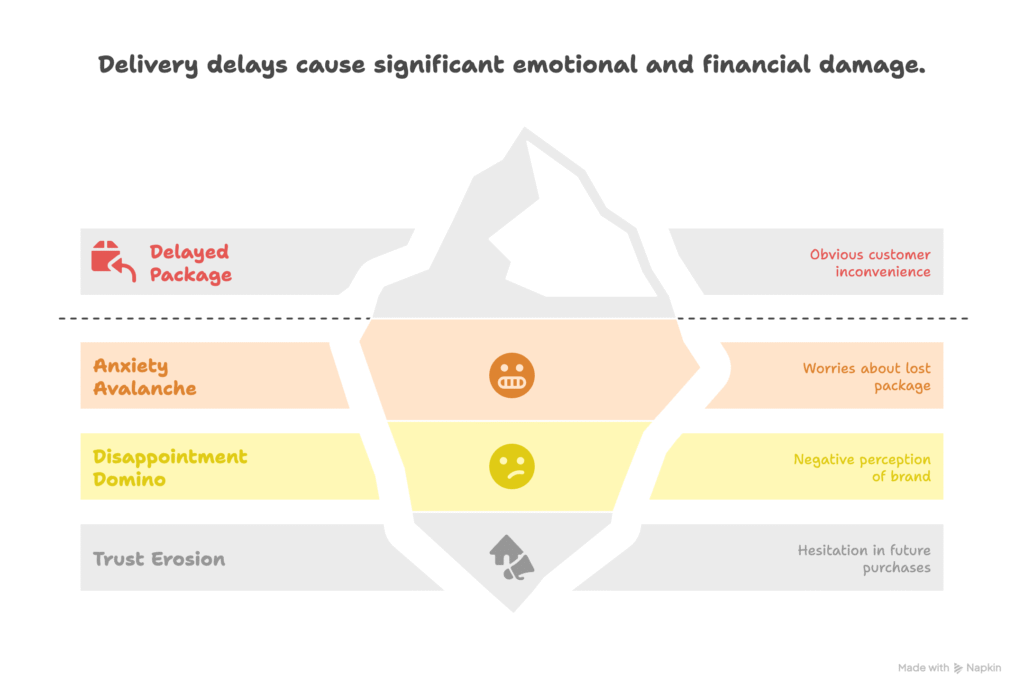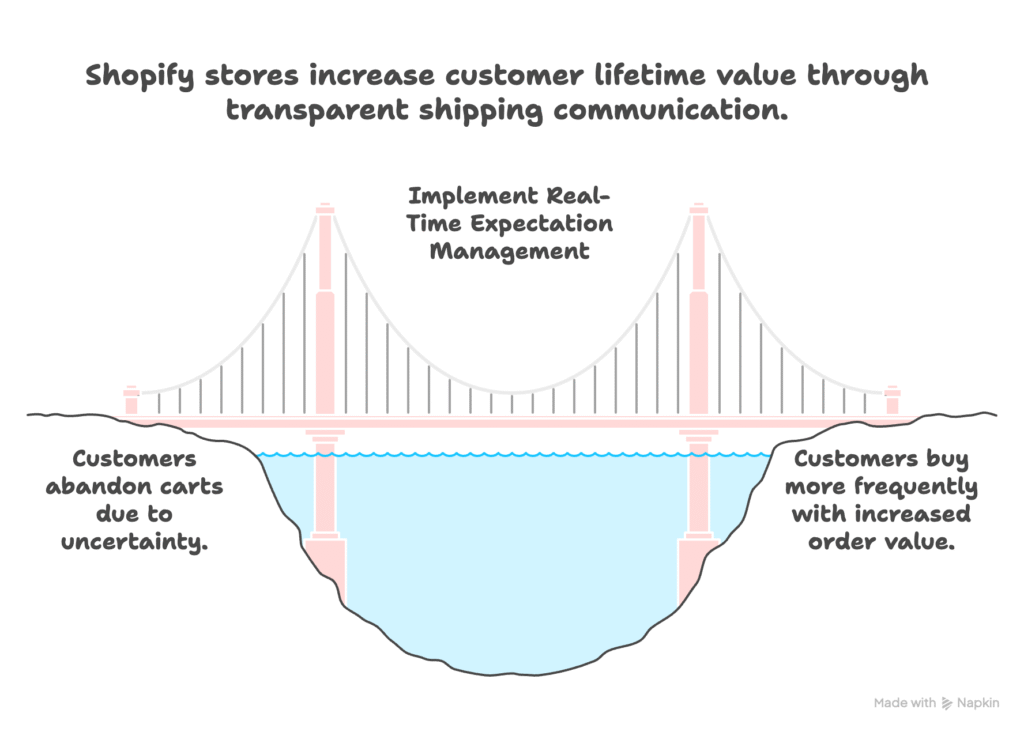Picture this: Your customer just clicked “buy now” on that perfect product they’ve been eyeing for weeks. Their heart races with excitement. But then what happens? They enter a psychological waiting game that could make or break their relationship with your brand forever.
Here’s the uncomfortable truth: waiting isn’t just about time—it’s about emotions. And those emotions are quietly determining whether your customers become loyal advocates or one-time buyers who never return.
Think your shipping strategy is just about getting packages from point A to point B? Think again. Every moment your customer waits is a moment their brain is either building trust in your brand or tearing it down, one anxious thought at a time.
By the time you finish reading this article, you’ll understand exactly how waiting affects your customers’ minds, why delivery delays can cost you far more than just shipping fees, and most importantly—how to turn the waiting experience into a competitive advantage that actually increases customer loyalty.
Ready to discover why some Shopify stores lose customers during shipping while others gain lifelong fans? Let’s dive in.
The Hidden Psychology Behind Every “Where’s My Order?” Email
When your customer places an order, something fascinating happens inside their brain. It’s not just excitement—it’s a complex neurological dance that determines their entire perception of your brand.
You see, our brains are wired with what scientists call “dual processing” when it comes to time perception. While one part of our mind logically understands that shipping takes time, another part is flooding our system with stress hormones, creating what researchers have identified as the “idle wait” phenomenon.
This isn’t just psychological theory—it’s measurable science. When people wait without knowing what’s happening, their prefrontal cortex lights up like a Christmas tree, desperately trying to fill in the gaps with worst-case scenarios. Your customers aren’t just waiting for their package; they’re actively worrying about it.
Here’s where it gets really interesting: the 18-30 age group shows the highest impatience levels, but here’s the twist—it’s not about age, it’s about conditioning. This generation has been trained by same-day delivery to expect instant gratification, creating what psychologists call “anticipation-desire relationship stress.”
But waiting isn’t always bad. Luxury brands have mastered the art of using anticipation to increase desire. The key difference? Communication and control. When customers feel informed and in control, waiting becomes anticipation. When they feel lost in the dark, waiting becomes anxiety.
Now that we understand what’s happening in your customers’ minds, let’s explore what happens when things go wrong—because the emotional consequences might surprise you.
When Delivery Delays Become Emotional Disasters
A delayed package isn’t just an inconvenience—it’s an emotional earthquake that can shake your customer’s trust to its core. Let’s break down exactly what happens when your customer’s package doesn’t arrive on time.

The Anxiety Avalanche
When a delivery is late, your customer’s brain doesn’t just think “oh well, it’ll come tomorrow.” Instead, it triggers a cascade of worries: Did they lose my package? Did I waste my money? Can I trust this store? This isn’t dramatic—this is basic human psychology.
The fear of non-arrival creates genuine psychological stress. Your customers start checking tracking numbers obsessively, refreshing their inbox, and yes—they start planning their complaints. Every delayed day multiplies their anxiety exponentially.
The Disappointment Domino Effect
Here’s what most store owners don’t realize: disappointment from shipping delays doesn’t stay contained to just shipping. It spreads like ink in water, coloring their perception of your entire brand.
When customers anticipate receiving their order for a special event or planned use, delays create what psychologists call “cognitive dissonance”—the painful gap between expectation and reality. This feeling is so powerful that it can override even positive experiences with your actual product.
Trust Erosion: The Silent Brand Killer
Perhaps most damaging is how delays slowly chip away at brand confidence. Each negative shipping experience creates hesitation in future purchase decisions. Your customers start asking themselves: “Should I risk ordering from them again?”
The word-of-mouth implications are staggering. A frustrated customer doesn’t just stop buying—they tell their friends, family, and social media followers about their negative experience. One shipping delay can cost you dozens of potential customers you’ll never even know about.
But here’s the thing: understanding these emotional consequences is just the beginning. The real question is—how much is this actually costing your business? Let’s look at the numbers that might shock you.
The Real Cost of Making Customers Wait (Spoiler: It’s Higher Than You Think)
Ready for some eye-opening statistics? 47% of omnichannel consumers will shop elsewhere when delivery times are excessive. But that’s just the tip of the iceberg when it comes to how waiting impacts your bottom line.

The Conversion Rate Connection
Here’s a number that should make every Shopify store owner pay attention: stores that provide transparent shipping information see a 25% increase in conversion rates. Why? Because uncertainty kills conversions faster than high prices do.
When customers can’t find clear shipping information, their brains default to worst-case scenarios. They assume your shipping will be slow, expensive, or unreliable. So they leave. Just like that, you’ve lost a sale—not because of your product or price, but because of shipping anxiety.
Cart Abandonment: The Shipping Surprise Attack
You know that sinking feeling when you see high cart abandonment rates? Hidden shipping costs and unclear delivery timelines are primary abandonment triggers. Your customers get all the way to checkout, see shipping details that don’t match their expectations, and vanish.
But here’s the encouraging part: stores that implement real-time expectation management see dramatic reductions in drop-off rates. Transparency isn’t just nice to have—it’s a conversion optimization tool.
The Customer Lifetime Value Impact
Perhaps most importantly, there’s a direct correlation between shipping experiences and customer lifetime value. Customers who have positive shipping experiences don’t just buy again—they buy more frequently and spend more per order.
Research shows a remarkable 0.906 correlation coefficient between communication quality and customer satisfaction. In simple terms: the better you communicate about shipping, the happier your customers are with everything else about your store.
Understanding these impacts is crucial, but if you’re running a Shopify store, you need specific strategies that work within the platform. Let’s explore exactly how to manage expectations using Shopify’s built-in tools.
Your Shopify Shipping Strategy Playbook
Now we get to the good stuff—specific, actionable strategies you can implement in your Shopify store today. These aren’t theoretical concepts; they’re practical tools that successful merchants use to turn shipping into a competitive advantage.
Mastering Platform Transparency
Shopify gives you powerful tools, but most merchants barely scratch the surface. Start with your processing time settings. This is where expectation management begins.
Instead of defaulting to generic settings, strategically choose between “Same business day” and “Custom processing time” based on your actual fulfillment capabilities. Honesty here builds trust that pays dividends later.
If you’re eligible, activate Shop Promise for automated delivery dates. This feature alone can dramatically reduce customer anxiety because it provides concrete expectations. For merchants who aren’t eligible, manual delivery date setup becomes even more critical—never leave customers guessing.
Communication That Actually Comforts
Your shipping policy isn’t just legal text—it’s a trust-building opportunity. Use clear, friendly language that explains your delivery timelines and what happens if delays occur. Avoid corporate jargon; write like you’re explaining to a friend.
Set up proactive delay notification systems. Don’t wait for customers to contact you about delays—reach out first. This simple action transforms a negative experience into a demonstration of good customer service.
The Multi-Channel Update Strategy
Your customers live in a multi-channel world, so your communication should too. Set up both email and SMS notifications for order updates. Provide tracking numbers immediately when available—transparency creates calm.
During peak seasons or when you know delays are possible, use banner announcements on your site and integrate messaging into your checkout process. Managing expectations upfront prevents disappointment later.
These platform-specific strategies are essential, but they’re just the foundation. To really excel, you need evidence-based approaches that address the psychological aspects of waiting we discussed earlier.
Science-Backed Strategies to Turn Waiting Into Winning
Here’s where psychology meets profit. These strategies are based on actual research into how people experience waiting—and how smart merchants use this knowledge to create better customer experiences.
The Expectation Setting Framework
Remember that statistic about 66% of consumers considering delivery options in platform selection? This is your competitive opportunity. While your competitors are vague about shipping, you can differentiate through honest, detailed communication.
Provide accurate delivery estimates during checkout—not best-case scenarios, but realistic timelines you can consistently meet. It’s better to under-promise and over-deliver than to create disappointment.
Offer multiple shipping options when possible. Some customers prioritize speed, others value cost savings. By providing choices, you give customers control—and perceived control reduces anxiety dramatically.
Building Psychological Comfort
Real-time package tracking isn’t just convenient—it’s anxiety medicine. When customers can see their package moving toward them, their stress levels drop significantly. Even when packages are delayed, tracking information keeps customers calm because they understand what’s happening.
Delivery customization options, like choosing delivery windows or locations, enhance perceived control even further. The more control customers feel they have, the more comfortable they are with waiting.
The Power of Proactive Communication
Regular status updates aren’t just good service—they’re stress reduction protocols. Each update serves as a psychological reassurance that their order is being handled properly.
Train your support team in empathetic communication. When customers do contact you about shipping concerns, how you respond can transform a worried customer into a loyal advocate.
These psychological strategies work, but you need operational excellence to support them. Let’s dive into the practical systems that make great shipping communication possible.
Building Operational Excellence in Shipping Communication
Great shipping experiences don’t happen by accident—they’re the result of well-designed systems and processes. Here’s how to build operational excellence that supports your customer communication goals.
The Multi-Option Strategy
Not every customer values the same thing. Some prioritize speed, others care about cost, and some want eco-friendly options. Your shipping strategy should reflect this diversity.
Offer standard, expedited, and if possible, same-day delivery options. This isn’t just about providing choice—it’s about optimizing for different customer preferences and willingness to pay.
Conduct cost-benefit analysis for each shipping tier. Sometimes, offering free shipping with slightly higher product prices converts better than showing separate shipping charges. Test what works for your specific audience.
Automation That Actually Helps
Synchronize your shipping software with Shopify platforms for seamless operation. Manual processes create delay opportunities and error possibilities—automation eliminates both.
Set up automated label printing and carrier assignment based on order criteria. The faster you can process orders, the sooner you can provide tracking information to anxious customers.
Communicate real-time inventory levels to prevent disappointment. Nothing destroys trust faster than taking orders for products you can’t ship promptly.
The Return and Exchange Psychology
Your return policy communication affects purchase decisions, but it also impacts shipping anxiety. When customers know returns are easy, they worry less about ordering.
Provide pre-paid return labels when possible and give clear instructions for exchange procedures. The easier you make returns, the more confident customers feel about purchasing.
Use post-purchase engagement to maintain the relationship. Include personalized thank-you notes, offer discount codes for future purchases, and solicit feedback for continuous improvement.
Having great systems is important, but how do you know if they’re actually working? Let’s explore how to measure and optimize the emotional impact of your shipping experience.
Measuring What Matters: Tracking Emotional Impact
You can’t improve what you don’t measure, and the emotional impact of shipping is absolutely measurable. Here are the key metrics that reveal how your shipping experience affects customer emotions—and your bottom line.
Beyond Basic Metrics
While delivery time is important, customer satisfaction scores during waiting periods tell you much more about the emotional experience. A customer might receive their package on time but still feel anxious throughout the process.
Track support ticket volume related to delivery anxiety. High volumes of “Where’s my order?” emails indicate communication gaps, not necessarily shipping delays. This metric helps you identify expectation management opportunities.
Monitor your Net Promoter Score correlation with delivery experience. Customers who have positive shipping experiences are much more likely to recommend your store to others.
Behavioral Analytics That Tell the Real Story
Repeat purchase rates following delivery experiences reveal long-term impact. Customers who have positive shipping experiences don’t just buy again—they become your best customers.
Analyze review sentiment during waiting periods. Comments about shipping often appear in product reviews, giving you insights into how shipping affects overall satisfaction.
Track cart abandonment rates specifically at shipping information disclosure. If abandonment spikes when shipping details appear, you know where to focus improvement efforts.
Continuous Improvement Through Feedback
Implement post-delivery satisfaction surveys that specifically ask about the shipping experience. Most surveys focus on product satisfaction but miss the crucial shipping journey.
Monitor real-time chat sentiment for shipping-related conversations. The language customers use reveals their emotional state—frustrated, confused, or confident.
Analyze reviews systematically for delivery experience insights. Customers often mention shipping in product reviews, providing valuable feedback about your entire fulfillment process.
Use A/B testing frameworks to optimize communication timing, transparency levels, and delivery option presentation. Small changes in how you present shipping information can have dramatic impacts on conversion and satisfaction.
Measuring current performance is crucial, but what about the future? Let’s explore the emerging trends that will shape shipping experience management in the coming years.
The Future of Shipping Experience Management
The shipping landscape is evolving rapidly, and smart merchants are already preparing for the next wave of customer expectations. Here’s what’s coming and how you can stay ahead of the curve.
Technology That Transforms Waiting
AI-powered delivery time estimation is becoming more sophisticated every month. Soon, you’ll be able to provide incredibly accurate delivery predictions based on real-time data including weather, traffic, and carrier performance. Imagine telling customers exactly when their package will arrive—down to the hour.
Dynamic routing optimization isn’t just for major carriers anymore. Smaller logistics companies are offering sophisticated routing that automatically finds the fastest path to your customers, often reducing delivery times without increasing costs.
Proactive delay prediction systems will alert you to potential delays before they happen, allowing you to communicate with customers before they even realize there might be a problem. This level of proactive service transforms delays from negative experiences into demonstrations of exceptional care.
Enhanced Tracking Capabilities
Real-time GPS tracking integration is becoming standard, giving customers the same visibility they have with food delivery for all their purchases. When customers can see their package moving on a map, anxiety virtually disappears.
Delivery window narrowing technologies will soon allow 1-2 hour delivery windows instead of full-day ranges. Customers value predictability as much as speed—knowing exactly when to be home eliminates stress.
Interactive delivery scheduling systems will let customers choose and modify delivery times even after ordering, providing the ultimate in perceived control.
Personalized Waiting Experiences
Individual tolerance threshold recognition systems will learn each customer’s patience level and communication preferences. Some customers want frequent updates, others prefer to be left alone until delivery—technology will soon accommodate both preferences automatically.
Adaptive expectation management systems will adjust communication based on customer history, current circumstances, and even local events that might affect delivery.
The Sustainability Factor
Environmental consciousness is increasingly influencing delivery choices. Customers are becoming willing to wait longer for eco-friendly shipping options, but they need clear communication about the environmental benefits they’re supporting.
Carbon-neutral delivery option messaging will become a competitive differentiator, allowing environmentally conscious customers to feel good about waiting a little longer for sustainable shipping.
The future of shipping isn’t just about faster delivery—it’s about smarter communication, better prediction, and more personalized experiences that make waiting feel worthwhile.
Your Next Steps: Turning Shipping Into Your Secret Weapon
We’ve covered a lot of ground together. From the neurological impact of waiting to future trends in shipping technology, you now understand that shipping isn’t just logistics—it’s psychology, emotion, and opportunity all wrapped into one.
Here’s what you’ve learned: Your customers’ brains are constantly evaluating their shipping experience, making split-second decisions about whether to trust your brand. Every moment they wait without information is a moment they might be planning to shop elsewhere.
But here’s the opportunity: While your competitors treat shipping as a necessary evil, you can transform it into a competitive advantage. Through transparent communication, proactive updates, and genuine care for the customer experience, shipping becomes a way to build trust rather than test it.
The strategies we’ve discussed aren’t just theories—they’re proven approaches that successful Shopify merchants use every day to turn anxious waiters into loyal customers. The question isn’t whether you can afford to implement these strategies; it’s whether you can afford not to.
Start small. Pick one or two strategies that resonate most with your current challenges. Maybe it’s improving your shipping policy language, or setting up proactive delay notifications. Every improvement compounds over time.
Remember: your customers don’t just buy your products—they buy the entire experience. Make that experience remarkable, starting from the moment they click “buy” until the moment they receive their package, and you’ll have customers for life.
Speaking of remarkable experiences, if you’re looking to take your Shopify store’s conversion optimization to the next level, consider exploring Growth Suite—an intelligent app designed to help Shopify merchants increase conversions through smart, targeted offers that maintain brand integrity while boosting sales. Because sometimes, the best way to reduce shipping anxiety is to ensure customers are completely satisfied with their purchase decision from the very beginning.




